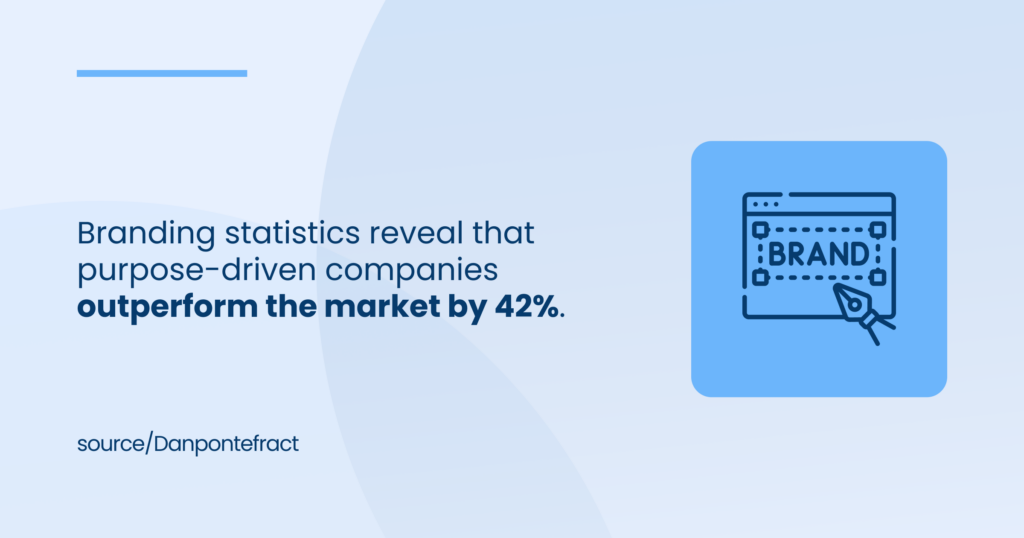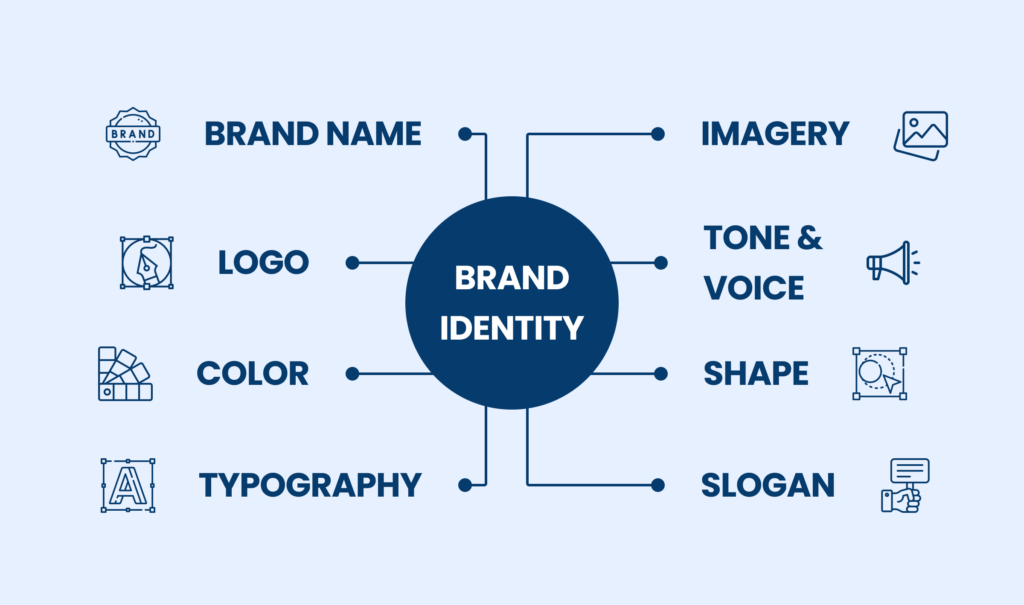Why does building a brand matter for your business?
In today’s crowded market, a successful brand has more than a flashy logo or a catchy slogan.
It’s about creating a memorable brand identity that connects deeply with your target audience and sets your business apart from the competition.
Whether you’re a business owner starting fresh or looking to revitalize your existing business, a strong branding guide is essential for establishing a meaningful connection with your customers and bringing long-term success.
A well-defined business branding guide provides a solid foundation for all your marketing efforts.
It clarifies your brand values, defines your brand voice, and outlines how to maintain consistency across all brand assets.
From your brand’s logo and visual identity to your brand messaging and social media presence, every element should align with your business’s core values and unique value proposition.
Building a brand that resonates needs more than just creativity; it demands strategic planning and a deep understanding of your market.
Effective branding involves conducting market research, identifying customer pain points, and making a brand story that aligns with your audience’s needs and aspirations.
By focusing on these elements, you can have an emotional connection with your audience, changing them into loyal customers who are invested and interested in your brand’s achievements and success.
At Azarian Growth Agency, we specialize in helping businesses create compelling brand strategies through a range of services, including our website building agency, which focuses on creating high-impact digital experiences that enhance brand recognition and drive customer engagement.
By leveraging digital marketing tools and crafting brand guidelines that ensure consistency, we help businesses develop a powerful and cohesive brand identity that truly resonates.
In this branding guide, we will explore how you can build a brand that not only stands out but also builds meaningful connections with your customers, ensuring long-term growth and success.
Ready to transform your brand into a memorable and impactful force in the market?
Let’s dive in.

Understanding Your Brand’s Purpose and Vision
Branding statistics reveal that purpose-driven companies outperform the market by 42%.
As an entrepreneur, defining your brand’s purpose and vision is critical to stand out in a crowded market.
This section of the entrepreneur’s Branding Guide will help you clarify why your brand exists and how it can resonate and connect with your target audience for creating a Brand That Resonates.
1. Defining Brand Purpose: Why Your Business Exists Beyond Making Money
Understanding the brand’s purpose goes beyond profit—it’s about making a meaningful impact. Here’s how to define your purpose effectively:
- Identify Core Values: Pinpoint what your brand stands for. Are you committed to sustainability, innovation, customer service, or community development? These core values should be at the heart of your brand.
- Solve Real Problems: Determine the specific problems your products or services address. A shoe company might focus on ethical manufacturing, providing both quality and environmental sustainability.
- Create an Emotional Connection: Your purpose should resonate emotionally with your customers. Use storytelling to highlight your mission and vision, fostering an emotional connection that encourages loyal customers.
2. Crafting a Vision Statement: How a Clear Vision Guides Your Brand’s Direction
A clear vision statement is essential for guiding your brand strategy and ensuring all efforts align with long-term goals. Here’s how to craft an impactful vision:
- Envision the Future: Think about where you want your brand to be in 5, 10, or 20 years. For instance, if you specialize in custom website development, you might aim to become the leader in ecommerce website design and website optimization.
- Be Specific and Inspiring: Your vision should be ambitious yet achievable. It should inspire not only your team but also your customers. This direction helps in creating a consistent brand image and influences your marketing materials.
- Align with Brand Values: Ensure your vision reflects your brand values and is consistent with the overall brand identity. This consistency helps build brand recognition over time.
3. Aligning Purpose with Customer Needs: How to Connect Your Brand’s Purpose with the Audience’s Desires and Problems
Aligning your brand’s purpose with customer needs is crucial for relevance and impact. Follow these steps to connect effectively:
- Do Market Research: Collect data on your target audience to get to know their needs and pain points. Use Google Analytics and other analytical tools to gain insights into customer behavior.
- Tailor Brand Messaging: Based on your findings, refine your brand messaging to address specific customer concerns. For example, if your audience values fast service, emphasize speed and efficiency in your web design and development.
- Showcase Value Proposition: Clearly communicate how your brand’s offerings solve customer problems. Highlight your unique value proposition in all social media and digital marketing efforts to demonstrate why your brand is the best choice.
- Build a Memorable Brand Identity: Use visual elements such as your brand’s logo, color palette, and overall aesthetic to create a memorable brand identity that appeals to your audience. Consistent visual identity strengthens brand recall and loyalty.
Crafting Your Brand Identity
To establish a memorable presence in a competitive market, you need to create a strong brand identity.
Your brand identity encompasses everything from your visual elements to your brand voice, shaping how customers perceive and interact with your business.
We’ll explore key aspects of building a cohesive and impactful brand identity.

Defining Your Visual Identity
Your visual identity includes all the design elements that represent your brand, such as your brand’s logo, color palette, typography, and imagery. These elements should work together to create a consistent and recognizable look.
- Choose a Distinctive Logo: A well-designed custom logo is essential for brand recognition. It should reflect your brand’s core values and be simple enough to be memorable yet unique enough to stand out.
- Select a Consistent Color Palette: Colors can evoke specific emotions and help define your brand’s personality. Choose a palette that aligns with your brand’s tone and resonates with your target audience.
- Consistency in Typography: Use fonts that align with your brand voice and overall brand image. Constant typography helps in creating a cohesive look across all your marketing materials and social media posts.
Source: Coca Cola company
Developing Your Brand Voice
Your brand voice is how you communicate with your audience. It reflects your brand’s personality and should be consistent across all communication channels.
- Identify Your Brand Personality: Decide on the tone of your communication—whether it’s formal, casual, authoritative, or friendly. Your brand voice should reflect your brand’s mission and connect with your audience.
Source: Lamborghini
- Craft Consistent Messaging: Your brand messaging should clearly communicate your unique value proposition and answer the needs of your customers. Consistent messaging helps in building trust and brand recognition.
- Create Brand Guidelines: Develop brand guidelines that outline how your brand voice and messaging should be used. This ensures consistency in all your communications, from website content to social media interactions.
Building a Cohesive Online Presence
A strong online presence is vital for any brand. Your website is often the first point of contact for potential customers, so it’s important that it reflects your brand identity.
- Focus on Website Design and Development: Invest in professional website design and development. Your website needs to be good-looking and user-friendly. All websites today have to be optimized both for desktop and mobile devices to allow an enriched experience for all users.
Source: Frans Art Museum
- Leverage CMS Integration: Use a Content Management System (CMS) to manage and update your website easily. Understanding what is headless CMS can offer flexibility in managing content across various platforms while maintaining a consistent brand identity.
- Implement SEO Best Practices: Optimize your website to make it search engine friendly and appear at better positions in search results. Focus on keywords related to your industry, such as custom website development, ecommerce website design, and digital marketing, to attract relevant traffic.
Utilizing Social Media to Reinforce Brand Identity
Social media platforms are powerful and necessary tools for building and reinforcing your brand identity. They offer a range of opportunities to engage directly with your audience and show your brand personality.
- Choose the Right Platforms: Select social media channels that are popular with your target audience. Platforms like Instagram, Facebook, and LinkedIn each offer different ways to connect with your audience and should be used strategically.
Source: Cartier
- Maintain Visual Consistency: Use your brand’s logo, color palette, and imagery consistently across all social media profiles. This helps with building brand recognition and makes your content easily identifiable.
- Engage with Your Audience: Use your brand’s voice to interact with followers, respond to comments, and participate in relevant conversations. Engaging with your audience helps build community and loyalty.
Building a Compelling Brand Story
In the early 1970s, three friends opened a small coffee shop in Seattle with a simple mission: to bring high-quality coffee beans to their local community.
This shop, now known as Starbucks, quickly became more than just a place to grab coffee.
It was a space where people could connect, relax, and enjoy the art of coffee-making. By crafting a compelling brand story around quality, community, and experience, Starbucks grew from one small shop to a global powerhouse.
Source: Starbucks
This story of origins and commitment resonated deeply with customers, creating a loyal following that helped fuel the brand’s expansion.
How to Build Your Own Compelling Brand Story
- Define Your Brand’s Origin and Purpose: Start with the reasons behind your business’s creation. What inspired you to start your company? What problems are you solving? For example, if you are in custom website development, your story could highlight a commitment to helping small businesses succeed online through innovative, easy-to-use web solutions.
- Incorporate Your Brand Values and Mission: Clearly define your brand values and mission. Share how these guide your business decisions. A company specializing in ecommerce website design might focus on providing seamless shopping experiences that drive sales and customer satisfaction. Show how your values shape your work and set you apart from competitors.
- Use Your Story in All Branding and Marketing: Make sure your brand story is reflected in your website building, web design and development, and marketing efforts. Include it in your website optimization to improve user engagement and SEO. Use consistent messaging and CMS integration across all platforms to keep your brand story alive. Whether you’re explaining what a headless CMS is or demonstrating how to create a brand identity, align every piece of content with your story.
- Highlight Customer Success and Real-World Impact: Share examples of how your brand has a positive impact on customers. This could be through testimonials, case studies, or success stories. Demonstrating real-world impact strengthens your brand story and builds trust with your target audience.

Measuring Brand Success
Statistics show that consistent branding across all platforms can increase revenue by up to 23%.
Measuring the success of your brand is needed to understand how well your brand identity resonates with your target audience and to identify areas for improvement.
Here are key metrics and strategies to effectively measure your brand’s impact:
- Brand Awareness and Recognition:
- Track website traffic and branded search queries using tools like Google Analytics.
- Monitor social media metrics like mentions, shares, and follower growth.
- Assess how effective your website building, web design and development, and digital marketing efforts are in enhancing brand visibility.
- Customer Engagement and Interaction:
- Check likes, comments, shares, and other engagement metrics on social media.
- Analyze how your social media posts and marketing materials are performing.
- High engagement indicates that your brand messaging and brand voice resonate with your audience.
- Customer Loyalty and Retention:
- Track repeat purchases, customer retention rates, and customer lifetime value (CLV).
- Use loyalty programs and email marketing to monitor customer loyalty.
- High retention rates reflect a strong brand story, effective brand strategy, and a compelling brand identity.
- Brand Perception and Sentiment Analysis:
- Use surveys and social listening tools to gauge customer sentiment.
- Analyze feedback on your brand values, brand personality, and overall brand image.
- Positive sentiment indicates strong brand resonance; negative feedback highlights areas for improvement.
- Website Metrics and SEO Performance:
- Monitor bounce rates, time on page, and conversion rates to evaluate website performance.
- Implement effective website optimization and SEO when building a website to enhance user experience.
- Regularly update your website to reflect your brand identity and improve performance.
- Sales and Revenue Growth:
- Track sales figures and revenue growth to measure the impact of branding initiatives.
- Analyze how changes in ecommerce website design, custom website development, and overall brand strategy influence sales.
- Increased sales and revenue indicate successful alignment with customer needs and market demands.
Scaling Your Brand as You Grow
As Starbucks expanded from a small coffee shop in Seattle to a global brand, it adapted its branding to stay relevant.
Initially, Starbucks’ logo featured a detailed, twin-tailed mermaid with the company’s name around it.
Over time, the logo was simplified, with the text removed and the mermaid design refined.
This change made the logo more modern and versatile, allowing Starbucks to maintain a consistent brand identity while appealing to a broader audience.
Source: thebrandingjournal
When scaling your brand, consistency is essential, but so is the ability to adapt.
As your business grows, regularly revisit your brand identity to ensure it aligns with new markets and customer needs.
For example, businesses in custom website development and ecommerce website design should update their branding to reflect new technologies like a headless CMS.
Maintaining consistency across all platforms—website building, social media, and offline marketing—is key to building brand recognition.
Use the color palette, typography, and visual elements that you have used before to create a cohesive look.
Regular website optimization and SEO practices will help keep your brand relevant and accessible as it scales.
Finally, use data to guide your branding decisions.
Monitor customer feedback, track engagement through Google Analytics, and adjust your brand strategy based on these insights.
This data-driven approach will help ensure your brand grows effectively with your business.
Take Your Branding to the Next Level with [A] Growth Agency
Creating a brand that resonates and scales with your business is a critical component of long-term success.
By defining a clear brand purpose, crafting a memorable brand identity, and sharing a compelling brand story, you can build a strong emotional connection with your target audience.
Consistently measuring brand success and being adaptable as you grow will ensure your brand remains relevant and impactful.
If you’re looking to elevate your brand and drive growth, partnering with the right experts can make all the difference.
At [A] Growth Agency, our team specializes in Website Building and digital marketing strategies that help businesses like yours thrive.
Whether you need help with web design and development, SEO optimization, or creating a comprehensive branding guide, we’re here to support you every step of the way.
Visit our Website Building Agency to learn more about how we can help you build a powerful, resonant brand that drives success.

